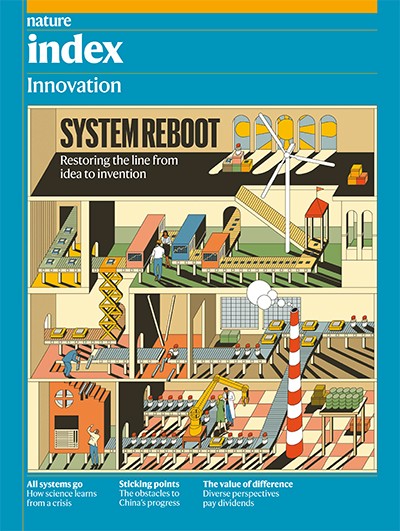The Nature Index is a database of author affiliations and institutional relationships. The index tracks contributions to research articles published in 82 high-quality natural-science journals, chosen by an independent group of researchers.
The Nature Index provides absolute and fractional counts of article publication at the institutional and national level and, as such, is an indicator of global high-quality research output and collaboration. Data in the Nature Index are updated regularly, with the most recent 12 months made available under a Creative Commons licence at natureindex.com. The database is compiled by Nature Portfolio.
Nature Index metrics
The Nature Index uses Count and Share to track research output. A country/territory or an institution is given a Count of 1 for each article that has at least one author from that country/territory or institution. This is the case regardless of the number of authors an article has, and it means that the same article can contribute to the Count of multiple countries/territories or institutions.
To glean a country’s, territory’s, region’s or an institution’s contribution to an article, and to ensure that they are not counted more than once, the Nature Index uses Share, a fractional count that takes into account the share of authorship on each article. The total Share available per article is 1, which is shared among all authors under the assumption that each contributed equally. For instance, an article with 10 authors means that each author receives a Share of 0.1. For authors who are affiliated with more than one institution, the author’s Share is split equally between each institution. The total Share for an institution is calculated by summing the Share for individual affiliated authors. The process is similar for countries/territories, although complicated by the fact that some institutions have overseas labs that will be counted towards host country/territory totals.
Adjusted Share accounts for the small annual variation in the total number of articles in the Nature Index journals. It is arrived at by calculating the percentage difference in the total number of articles in the Index in a given year relative to the number of articles in a base year and adjusting Share values to the base year levels.
The bilateral collaboration score (CS) between two institutions A+B is the sum of each of their Shares on the papers to which both have contributed. A bilateral collaboration can be between any two institutions or countries/territories co-authoring at least one article in the journals tracked by the Nature Index.
NATUREINDEX.COM
natureindex.com users can search for specific institutions or countries and generate their own reports, ordered by Count or Share.
Each query will return a profile page that lists the country or institution’s recent outputs, from which it is possible to drill down for more information. Articles can be displayed by journal, and then by article. Research outputs are organized by subject area. The pages list the institution or country’s/territory’s top collaborators, as well as its relationship with other organizations. Users can track an institution’s performance over time, create their own indexes and export table data.
This supplement
The Nature Index 2022 Innovation supplement uses The Lens database to check the influence of an institution’s scholarly works on patents.
For each of the leading 500 institutions in the Nature Index (based on Share 2021), its scholarly works between 2000 and 2020 (Scholarly works 2000–20), including journal articles, conference proceeding articles, books and book charters, were queried from The Lens database. All the Lens patents that cite its scholarly works were also uniquely counted. The unique count of citing patents (Citing patents) was then divided by the total number of the scholarly works to measure the institution’s influence on patents. This normalized measure, namely patent influence metric, was used to rank the 500 institutions. Academic, government and NPO/NGO institutions were also extracted from the leading 500 and ranked separately by the metric for each of the three sectors. Those sector rankings didn’t include any subsidiary research institutions.
Apart from scholarly works and citing patents that were used to derive the patent influence metric, there were two other useful measures extracted from The Lens database for each leading institution. The first was the count of the scholarly works between 2000 and 2020 that are cited by patents (Works cited by patents 2000–20). The second was total patent citations (Patent citations), which is the sum of all citations of an institution’s scholarly works between 2000 and 2020 in patents.
The tables show the overall institution ranking by patent influence metric as well as the leading institutions in academic, government and NPO/NGO sectors. A Lens input data table lists all the Lens measures, scholarly works, citing patents, works cited by patents and patent citations for each institution.


 Overcoming the obstacles to invention
Overcoming the obstacles to invention
 The institutions forging the strongest innovation links
The institutions forging the strongest innovation links
 How the pandemic inspired a new generation of creators
How the pandemic inspired a new generation of creators
 Diversity and inclusion is a must to make innovation work for all
Diversity and inclusion is a must to make innovation work for all
 How leading nations fare on applying knowledge
How leading nations fare on applying knowledge
 Is China open to adopting a culture of innovation?
Is China open to adopting a culture of innovation?


